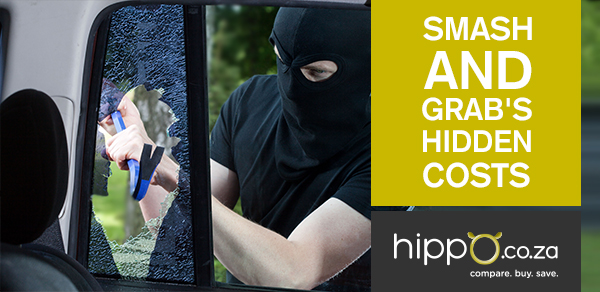Smash-and-grab's hidden costs
Many South Africans have been the unfortunate victims of smash-and-grab attacks on their cars. This form of crime is self-explanatory as robbers literally smash windows and grab whatever valuables they are able to get their hands on inside your vehicle, which they can then sell at a later stage. Criminals are getting smart though and at times will go further by placing the victim under duress either at knife or gunpoint. In these cases, the robbery moves straight from a smash and grab into other territory, closer to a hijacking. Another example of this is when criminals take the car keys and begin bartering for valuables which he/she believes are in the boot or glove compartment. In this way a hijacking is avoided but smaller possessions which are easy to fence are stolen. There are some ways to stop a smash-and-grab, a very popular one being smash-and-grab protection film. Hippo.co.za takes a look at some of the common issues and misconceptions surrounding smash-and-grab attacks, how they could be avoided and what exactly to do if it ever happens to you.

How smash-and grab protection works
Using Hippo.co.za, the free comparison website we looked at the profile of a typical female (women are usually targeted in these attacks) and did an indicative quote to determine how having protection could affect your premium. The quote was based on a 29-year old woman who:
- has had her licence for five years
- has two years of uninterrupted insurance cover since her last claim
- drives a brand new 2014 Toyota Corolla 1.6 Professional
- parks overnight in an access controlled area (let's just imagine that she lives in an apartment complex with a boom-gate and security)
- is the only driver of her car
The basic insurance quotes range from R542 for the cheapest monthly premium and R1661 for the most expensive. What is surprising is that the excess for the cheapest option is only R1100 more than the excess of the most expensive option and both include hail damage. When you look at all this at a surface level, it all sounds very similar. The nitty-gritty actually lies in whether you get more money discounted for having certain protective measures already installed, including tracking devices, smash-and-grab protection and more. So what happens if you ever have your car smashed into and now want to claim from insurance? Besides that, how do know if your smash-and-grab tinting is the genuine product?
Rian Swart, Managing Director of Secure Fit, the safety film division of Glasfit explained the basic criteria for smash-and-grab film for us:
"Normal window tinting varies in thickness from 25 micron (micrometres) to 50 micron. Safety film designed to keep the window intact in the event of a smash-and-grab attack varies in thickness from 100 micron up to 400 micron. The most used thickness is 100 micron, although some dealerships insist on using 150 micron-thick film."
As a result of this variability, it does unfortunately mean that you may think that your safety film is the thicker of the two and be wrong. Many consumers are not clued-up as to how often this film should be replaced – a 150 micron-thick film can tear – or if they have genuine smash-and-grab technology that meets the minimum thickness, as opposed to simple tinting.
So, for a 29-year old woman paying R542 a month as opposed to R1661, how do you know you're getting the best value for your money?
Depending on thickness, good quality safety film is between R1500 for a small vehicle up to R3000 for a big SUV. This means, depending on your vehicle, you could pay more or less, in addition to the actual quality of the safety film. Most of the time this is a cost that is not included in your insurance quotation as you are expected to fit your own protective devices to limit the liability both you and your insurance provider face in driving an unprotected car. Most safety film is either polyester or PET and is described as shatter safe or shatter resistant – not shatter proof. The adhesive-coated film bonds to the glass and has a high optical clarity so that light continues to come in and out of the window.
How do criminals break through the glass?
You would think that most smash-and-grab attacks happen with bricks or similar heavy objects but according to Swart, "Criminals use the ceramic from a broken spark plug which is extremely hard and sharp. They throw it at the window and because [most] motor manufacturers toughen the side windows, they are brittle and shatter."
Science is behind this explanation since tempered glass, which is used for vehicular side windows is manufactured with a high surface compressive stress and high internal tensile stress, making it strong and durable. But these factors also mean that it will shatter into thousands of pieces when broken. There are a number of layman experiments showing just how easy it is to shatter tempered glass with 'ninja rocks' as the shards of spark plug ceramic are referred to.
How do you protect yourself?
- Reduce the chances of becoming a target by moving all of your valuables to the boot or glove compartment.
- Smash-and-grab car burglars aren't exactly criminal masterminds. Many simply act on impulse, so make sure to spot anyone who looks suspicious and raise an alarm if possible.
- Most of the time, smash-and-grabs happen at busy intersections in peak traffic. Make sure to stay most alert at those times.
- When you go to a dealership for smash and grab film, ask the right questions.
- If you see broken glass ahead of you it may be a sign that the intersection you're heading towards is a smash and grab hotspot.
More on the subject of protective film
An analytical chemist by profession, with 34 years of experience at 3M, Harry Corbett, compiled an in-depth study about the ways in which dealerships are failing the public and the insurance industry by neglecting to educate them about protective film. In his report he notes that large safety film manufacturing companies realised that various protective films, not designed as safety and security materials, were being sold to fitment centres and applied to vehicles as anti-smash-and-grab film. Again, with the way the tempered glass is so easily broken, one cannot be faulted for wondering whether the correct protective film is being used in the correct context. There is definitely more to the protective film supply-chain and management than meets the eye.
If you want to know more about dealerships potentially using the wrong film for the job and how it is that South Africans may be getting incorrect products, look out for our upcoming in-depth report on the workings of the protective film supply chain in SA.
Hippo Blog Categories

































